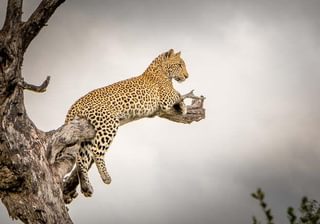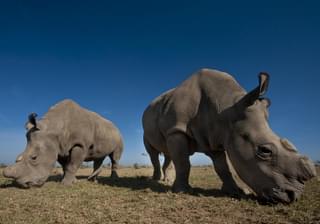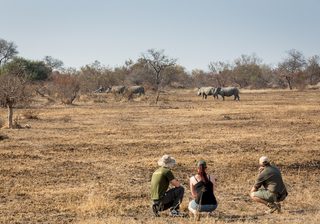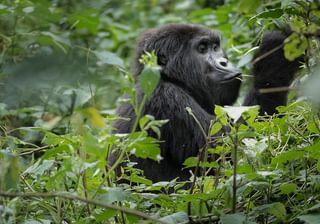A detailed itinerary tailor-made for you.
Start planning your tailor made vacation with Far & Wild.

Alistair
Travel Expert

So you've started planning your holiday, and you've heard Kenya safaris are phenomenal, but someone else says go to South Africa on holiday, how do you pick? We're going to break down for you where each country accelerates so you can choose the right one for you.
Kenya and South Africa are safari giants. Kenya is the birthplace of safari and is home to the renowned Masai Mara National Park, as well as sharing the Great Migration with Tanzania. South Africa on the other hand, has Kruger National Park and is known for being extremely family friendly. The country welcomes over 10 million visitors a year, in part due to its offering beyond safari: historic battlefields; the magic of Cape Town; the winelands; and beautiful scenery along its coastal roads. It also acts as hub to the rest of southern Africa so not all of those visitors stay in South Africa. Kenya is more safari focused, welcoming 2 million visitors by comparison, with almost all taking part in a safari as part of their visit, although a proportion of their number would be the ‘Mombasa only’ beach crowd. Nevertheless, these are the two most popular African destinations for international tourism in sub–Saharan Africa and both offer a wonderful array of options. There are some subtle differences, however, which could help you decide which destination is for you.
Let’s start with the obvious one - the abundance and variation of wildlife. Both South Africa and Kenya are rich in biodiversity and offer exceptional wildlife experiences. The specific biosphere density can vary depending on factors such as human population density, protected area networks, and the presence of flagship national parks (Masai Mara in Kenya and Kruger in South Africa).
Both countries are home to the Big Five (i.e. Lions, Leopards, Elephants, African buffalo and Rhinos). The Masai Mara in Kenya being particularly known for its dense concentration of big cats and for the Lewa region which is a world-leading area for rhino conservation. By comparison, the Kruger National Park in South Africa has high numbers of elephants, alongside the other Big Five animals, and because this is a larger national park with very varied terrain, all can be found here.
It's important to note that these densities can vary across different regions within each country, not to mention seasons and it would therefore be wrong to give one a higher general classification than the other. For example, during migration season in the Masai Mara the game concentration is likely to be higher than anywhere on earth, however this will lessen substantially once the migration period is over. Whilst in the Kruger area the game density tends not to fluctuate as much and is always a solid 9/10.
Marine life is also important and South Africa’s access to the whale migration is a huge plus, Kenya does offer dolphins, whales but not on the same level. Bottomline is, regardless of which country you visit your wildlife experience will be a good one, so long as you head to the right spots at the right time, making it almost impossible to call but if I had to, South Africa would get the nudge for its consistency and variety.


Geographically, South Africa covers a vast area and boasts a stunning array of landscapes, from the vast plains of the Kruger National Park to the dramatic coastline along the Garden Route. You can witness breath-taking sunsets, lush forests, and expansive savannahs. Kenya's landscape is similarly diverse, featuring a combination of impressive geographical features such as the Great Rift Valley, seemingly limitless plains, mountain ranges, dense forests, and stunning beaches.
Whilst both countries have incredible topography and scenery, Kenya comes out on top here as the respective Kenyan areas are far more accessible due to the more compact area and the relatively inexpensive access to the light air networks, both private and scheduled. This means you can be on safari in the far reaches of the northern plateau in the morning and by afternoon be enjoying a river crossing in the Masai Mara without going near anything that resembles an airport. South Africa does offer a network of light aircraft but it is not as far reaching as that in Kenya and it is generally more expensive.
The capital city of Kenya, Nairobi, contains the majority of the population so its very easy to get off the beaten path. However, if time is not a constraint, then South Africa offers a huge range of opportunities to explore across the country – Kruger, Madikwe, The Waterberg and Kwa-Zulu Natal in the northeast down to the rewilded areas of the Eastern Cape and Tswalu in the Kalahari.
In the past animals were the primary driver for going on a safari, often to tick off sighting the Big Five. These animals are still the main reason for visiting, but in recent years attitudes have shifted slightly and to accommodate this the concept of the safari has morphed into a more holistic experience. There is a wider variation of activities available with a greater emphasis on getting out of the safari vehicle to participate on foot in Walking Safaris or atop a horse in Horse riding Safaris, or maybe even get involved with local communities or anti-poaching programmes.
In my opinion this is a great thing as there is so much on offer when out in the bush. In the past, often the little things got overlooked in favour of ticking off the supposed bigger items. In creating these safari variations, the industry is mixing things up for the sake of the animals’ welfare, meaning that all parties have a better and more sustainable experience.
As you might expect, both Kenya and South Africa lead the field in terms of what you can do on safari. Take your pick from:
Bush walks, night drives, camera hides, authentic cultural interactions, and game drives you can do in both countries, not everywhere, but you will be able to find somewhere to do them. South Africa have numerous lodges that offer a ‘sleep out experience’ where you pack an overnight bag and are dropped at a secure platform about 10-15 minutes drive from the lodge. Here you will spend the night out under the stars armed with a radio and a goodie hamper filled with your dinner and generally a substantial amount of alcohol to help with the nerves. These experiences are completely safe and offer you the chance to have your boy scout moment and sleep out under the stars, albeit in comfort. Kenya tends not to offer these as much, possibly because most accommodation is tented anyway. However, it is a lovely thing to do especially as a surprise, a night you will never forget! For those who are not ready for a sleep out Garonga Safari Camp offer a bush bath – which is a bathing experience under the stars. Highly recommended too.
Kenya’s answer to the sleep out is to take it a step further and take the bushwalk, add a team of Samburu warriors with their camels and combine this with a three day (two night) walking safari where you sleep out under the stars in a different location each night on Karisia’s Private Conservancy in Laikipia. There are no vehicles in sight and although you are fully supported by your Samburu hosts and guide this is a proper off the map experience, with Mt Kenya in the background and the sky alight with millions of stars. The beauty of this trip is that it is a proper adventure through the northern reaches of Laikipia as you walk a large loop point to point. It is not for the faint hearted though as you are properly out there on your own, so while it is perfectly safe, it may be a bit edgy for some.


Hot Air Ballooning is an activity that is much more prevalent in East Africa. Kenya offers hot air ballooning over the Masai Mara and in Amboseli. If this is an activity you want to do, then it’s much more likely you will come across in Kenya rather than South Africa. It is offered in the Pilansberg National Park, but this is an area less frequented, certainly by first-time safari goers. Unfortunately, it is not available in South Africa's Kruger National Park because of weather conditions and the denser flora on the ground.
In the Masai Mara and Amboseli there exist huge plains where landing a balloon is much easier than finding your spot amongst the denser bush and the winds tend to be fairly reliable and consistent, but it does incur an early start, so be warned. Your typical balloon trip lasts about 50 minutes, and generally you will be airborne by the time the sunrises which allows for some incredible photos. You will then drift at various heights over the plains, forests and herds of game before coming into land (which can be a bit bumpy) and then treated to an excellent breakfast before continuing on your game activity with your guide.
A pretty amazing experience on offer in the Sabi Sands in South Africa at &Beyond’s Ngala Camp is assisting with rhino ear notching. This is used to identify the rhino, as well as, for security purposes. You embark on an exhilarating journey where you become an integral part of the day's thrilling escapade. While a skilled veterinary team scans the landscape from a helicopter, in search of a majestic rhino, you will eagerly trail behind in a robust 4x4 safari vehicle, guided by a knowledgeable ranger. Once the magnificent creature is spotted and safely sedated, the helicopter will gracefully touch down, granting you an extraordinary and unparalleled chance to gently interact with the tranquilized rhino during the unique notching procedure. This unforgettable encounter is sure to leave an indelible mark on you, and the rhino!
I could go on about these incredible activities. It’s akin to two heavy weights trading blows in the final round. There is so much on offer its impossible to choose.
When comparing luxury or upscale safari accommodations in Kenya and South Africa, there are some notable similarities and differences to consider. Both countries offer luxurious options for travellers but there are variations in terms of overall atmosphere and style.
In Kenya, safari accommodations lodges and camps are designed to blend harmoniously with the natural surroundings while providing a comfortable and opulent retreat for guests, most are stretched canvas offering spacious suites (e.g. Elephant Bedroom Camp), featuring private verandas or decks with breath-taking views of the plains or watering holes (e.g. Saruni Samburu). Accommodation here often emphasizes eco-friendly practices and provide opportunities for authentic cultural interactions with local communities.
On the other hand, higher-end safari accommodation in South Africa is often architecturally stunning, combining contemporary design with traditional African elements (e.g. Singita Sweni Lodge). They offer a range of accommodations, from lavish suites with private plunge pools to exclusive-use villas, providing a very secluded and intimate experience (e.g Indlovu River Lodge). Canvas tends to be less common in the south due to the greater fluctuation in temperatures.
Again, who am I to say what is better. They are just different! South Africa used to be more luxurious but as safari has developed in East Africa the more the southern African inspiration has influenced Kenya.
If you’re looking for a traditional beach and bush holiday, Kenya offers easy access to incredible beaches that offer a superb place to chill after your safari pretty much year-round whether you head to the Kenyan coast, like Mombasa, or a hop over to Zanzibar.
South Africa does have some beaches on the Garden Route, but its beaching for the brave generally due to water temperatures and for 6 months of the year the weather is inclement. If you want the best beaches here, you will need to head north to Mozambique, which whilst there are stunning archipelagos here, they take a bit longer to get to and are often quite pricey, so a less easy option than in Kenya.
However, South Africa offers a vast array of other options – explore cosmopolitan Cape Town home to Robben Island, indulge in the winelands, explore the famous Garden Route or discover the history of the battle fields. If you are looking for a varied holiday with a bit of safari thrown in, South Africa wins.
For those focused on a varied safari experience, Kenya is easy to combine 2 or even 3 different safari areas thanks to its strong internal flight network meaning you can experience different topography, wildlife, and activities easily. It can also be combined with Uganda if you are hoping to see gorillas.


Both countries offer a wide range of cost for their safaris, some surprisingly so considering the local standard of living. The biggest difference is the currency they are costed in and how that is trading against the currency you are paying in. Kenya charges in USD whereas South Africa is priced in South African Rand. So, if you are using a UK based operator (like us) you will be charged in GBP and the exchange rate difference between GBP and Rand or USD could save you a significant amount. Worth bearing in mind.
Another sizeable difference is the park or conservancy fees. In Kenya these are generally in excess of £80 per person per day. They tend to be less in South Africa meaning that if you are on a budget or longer safari this could shape your decision. From a buyer’s perspective SA wins here.
Good news here, both are easy to access with direct flights from the UK to Kenya or South Africa, and only an hour or two time difference for both, meaning no jetlag.
Once you are in the country, Kenya has a great network of internal flights to the various safari areas making air travel quick and easy, and in South Africa, the Kruger is a short hop from Johannesburg or an easy drive.
Both provide straightforward and easy access.
Sustainability is the key word in the tourism industry, never mind the safari industry. Camps in Kenya will in all probability have a lighter footprint as they will generate their own power due to their remote locations and the lack of infrastructure in the country. You are likely to see less air conditioning in Kenya than South Africa for example. However, Solar power has become very popular in the south and Kenya is still catching up here.
On the whole South Africa lead the field here, in my opinion, as they were the first country to develop the ‘private conservancy or concession’ and the success of the Sabi Sands has been a beacon to other countries on how the model works. Granted it’s not perfect but Kenya have adopted this model in the Masai Mara region too with great success. However, Kicheche in Kenya may claim to be the first to rid their operations of plastic bottles and champion refillable bottles.
Both country safari operators are excellent at:
There are numerous safari operators who can rightly call themselves Carbon Neutral – have a look at a blog on Carbon Neutral Safaris in Tanzania.
To say one is better than the other would be a misnomer. Both countries offer a huge range of unique safari experiences in their very own ecosystems and landscapes, from the desert lands of the Kalahari in South Africa to the Matthews Mountain Range in Kenya, a safari in either destination will blow your mind. The main difference for me is that I see South Africa as a more developed safari industry and Kenya as more one still developing - this may be unfair, but it’s how I see it. This has nothing to do with the actual safari experience or the standard of the camps or lodges but more to do with the countries themselves.
Kenya offers a wilder or rawer experience. As an example, the roads are not always great getting from A to B, whereas South Africa always has good, tarred roads right up to the park you are going to and sometimes even in the parks (see Kruger National Park), not that you want it. For me with this wilder feel comes a sense of being more at one with the great outdoors: less light pollution, more stars; fewer communities, wider plains.
Then South Africa does have the trump card of various non-malarial areas for young families or expecting mums. None of this makes one better than the other, just different. It means that there are lots of options and some people will be happier in one rather than the other, so explore all the options you can. And it might not even be in South Africa or Kenya as there are safaris available all over Africa, for example Namibia, Mozambique, Tanzania, Madagascar, or Ethiopia – there is something out there for everyone!
Looking for some more inspiration? Take a look at these articles to help you choose.
How much is a safari in Kenya?
A first time visitors' guide to Kruger National Park
Start planning your tailor made vacation with Far & Wild.

Travel Expert